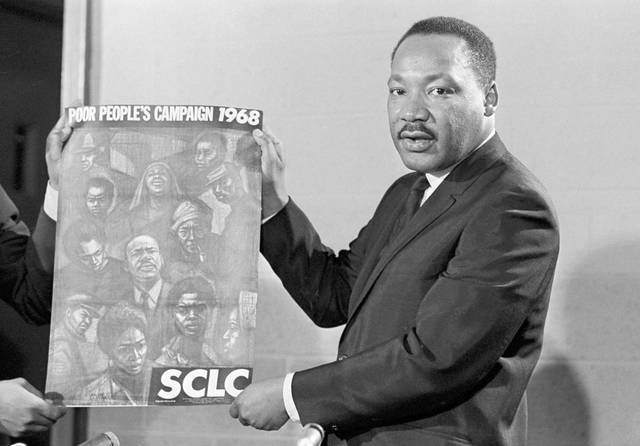Martin Luther King Jr.'s work touched Pittsburgh, continues today
King visits
Thousands of people squeezed into the pews of Central Baptist Church, excitement building as others lined the walls and the overflow crowd spilled out the doors onto Wylie Avenue in the Hill District.
Martin Luther King Jr. stood in the sanctuary, preparing to give a highly anticipated speech to Pittsburgh residents, who were in the midst of their own civil rights movement in 1958.
“It was quite electric, as well as challenging and motivating to those who attended,” said the Rev. Victor Grigsby, pastor of Central Baptist.
Over the course of a decade, King visited Pittsburgh five times, cautioning against segregation and fighting for the rights of blacks and the poor. And each time, rooms were filled to the brim as people waited to hear from a leader of a movement that eventually led to the desegregation of the nation.
“It is humbling to me to stand where he stood,” Grigsby said. “To see the pictures of the same place, the same pews, the same walls. Here I am trying to make my little impact, which is not only humbling, but at times intimidating.”
King and Pittsburgh
Alma Speed Fox fought for civil rights alongside King — although from different cities.
“I’m quite proud to be a part of the movement,” she said. “I grew up in an atmosphere that was discriminatory, but I didn’t realize it.”
Fox had lived in Pittsburgh for six years when King first visited the Hill District’s Ebenezer Baptist Church in 1956.
“I did not see him, but it meant a lot to me, the very fact that we had Martin Luther King Jr. to promote not only for black people, but for all people,” said Fox, 95.
When King made his first visit to Pittsburgh, he served as president of the Montgomery Improvement Association, an organization that urged thousands of people to boycott Montgomery, Ala., city buses for about a year, Pittsburgh Magazine reported. King was thrown into the role four days after Rosa Parks was arrested Dec. 1, 1955, for refusing to give up her seat on a crowded bus for white riders.
“The No. 1 thing I always wanted to show is how absolutely selfless he was,” said David Garrow, author of the Pulitzer Prize-winning biography “Bearing the Cross: Martin Luther King Jr., and the Southern Christian Leadership Conference.” “This is someone who did not want to be a public person.”
King preached at two services at Central Baptist in 1958 and returned to the city in 1960 to speak at the Freedom Jubilee at Forbes Field, said Liann Tsoukas, senior lecturer at the University of Pittsburgh. He spoke at the event again in 1961.
On Nov. 3, 1966, King made his final visit to the city, appearing at the University of Pittsburgh campus in Oakland for a speech titled “The Future of Integration.”
The student union’s stated capacity was 850 people, but as many as 2,000 students showed up to listen to the speech, Tsoukas said.
During his speech, King called for a “massive action program” to alleviate inner city issues and relieve the economic condition of African-Americans.
Three months later, he delivered his “I Have a Dream” speech at the Lincoln Memorial in Washington.
Keeping up the fight
On April 4, 1968, King was assassinated in Memphis, Tenn.
But his death didn’t slow down activists like Fox. Rather, it motivated her to keep fighting.
“Being black and being a woman, I had no choice,” Fox said.
Born in Cleveland, Fox said she was kept from situations and people that could be harmful to her or her family.
But at 13, she joined her first picket line, a choice that led her to participate in several Pittsburgh demonstrations against U.S. Steel. Activities such as demonstrations and picket lines are what change people and show them what is right, Fox said.
In 1966, Fox became director of the National Association for the Advancement of Colored People, a position she held for five years. After that, she became an equal opportunity manager for the U.S. Department of Interior, Bureau of Mines.
“That was a way of promoting civil rights,” Fox said.
Today, several people are fighting to keep King’s message alive in a culture that is still working to accept different religions, cultures and races, said John Welch, dean of students at the Pittsburgh Theological Seminary.
“It makes his message of love more important,” Welch said. “I wish we weren’t in the season we’re in right now.”
King’s message today
For Grigsby and Welch, fighting for racial equality is as important today as it was when King was alive.
“America has stopped moving forward in a place where race relations are concerned,” Grigsby said. It is “more black and white in our country than in the ’50s and ’60s.”
And in today’s society, King’s fight for racial rights applies to the “poor, immigrants, the ostracized,” said Timothy Kelly, history professor at Saint Vincent College in Unity.
King focused his sermons on America’s founding principles, specifically with Christian undertones, Kelly said. Through that focus, King was able to point out the dignity of each individual and the responsibility citizens have for each other, he said.
Fox has advice for young people continuing to fight for their rights.
“I can only tell them to protect themselves,” she said. “I see so many young people who do not know how they got there,” through “organizations such as the NAACP and people like Martin Luther King Jr.”
Megan Tomasic is a Tribune-Review
staff writer. You can contact Megan
at 724-850-1203, mtomasic@tribweb.com or via Twitter @MeganTomasic.
Remove the ads from your TribLIVE reading experience but still support the journalists who create the content with TribLIVE Ad-Free.


